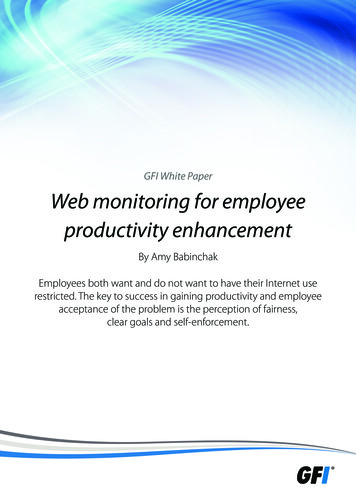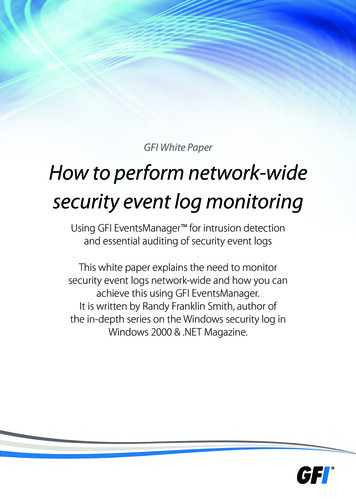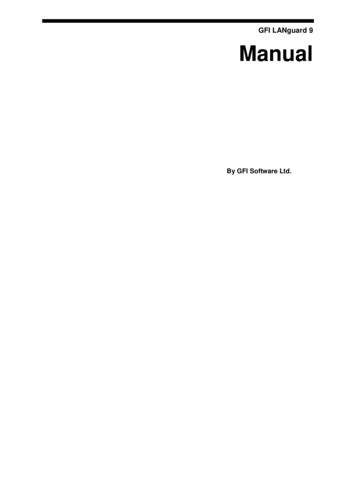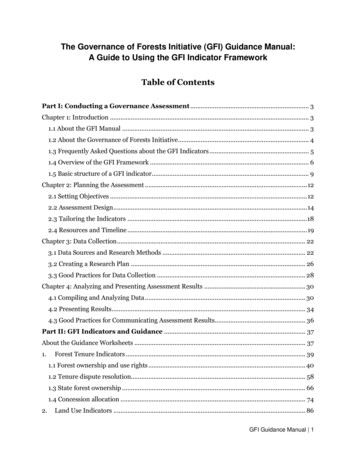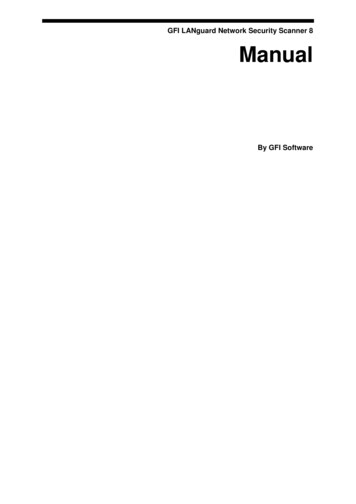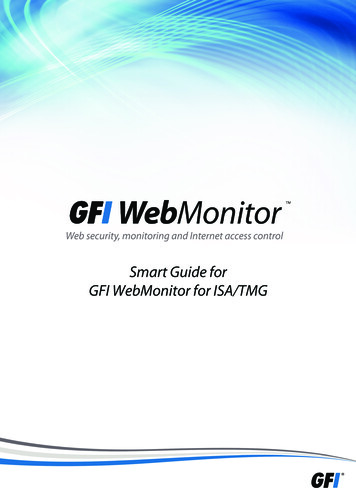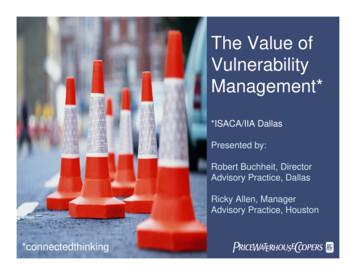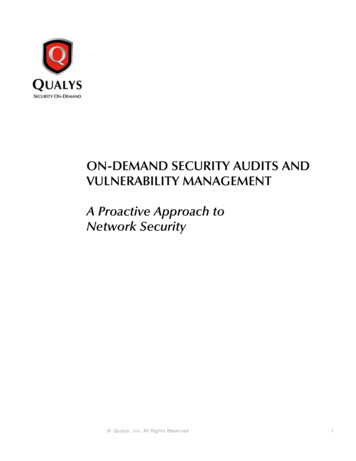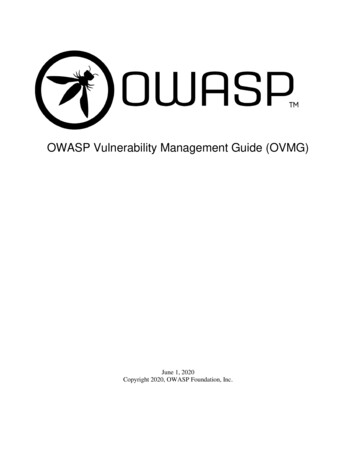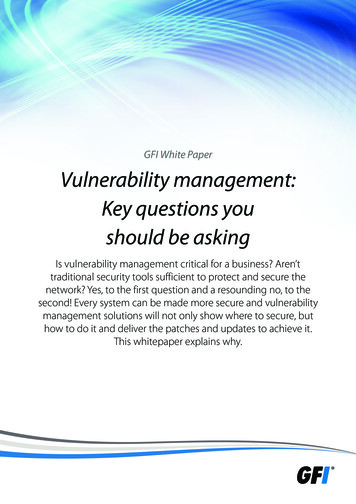
Transcription
GFI White PaperVulnerability management:Key questions youshould be askingIs vulnerability management critical for a business? Aren’ttraditional security tools sufficient to protect and secure thenetwork? Yes, to the first question and a resounding no, to thesecond! Every system can be made more secure and vulnerabilitymanagement solutions will not only show where to secure, buthow to do it and deliver the patches and updates to achieve it.This whitepaper explains why.
ContentsIntroduction3What is vulnerability management?3Key questions to ask4Summary5About GFI LanGuard 6About GFI 6Vulnerability management: Key questions you should be asking2
IntroductionVulnerabilities in IT systems present a continuing challenge for any IT department or IT manager, with anongoing need to address vulnerabilities as they are discovered in applications, operating systems andfirmware, as well as in the configurations of key hardware such as printers, switches and routers.While it can be argued that some of the common known vulnerabilities that are discovered in software andsystems are a result of errors introduced at the application programming stage, many more come aboutmore innocently, as a result of poor or inadvertent configuration of systems, legitimate changes made toenable functionality or to address an issue elsewhere in the IT ecosystem. Or vulnerabilities can even manifestwhen a unique set of circumstances or software combinations come together in one environment, creatingincompatibilities and clashes that create an exploitable vulnerability.Often, vulnerabilities are caught early on in their lifecycle and addressed through the established processof applying patches and service packs from the software vendor. Others are not addressed straight away, oraffect such a small number of users that it is neither practical nor financially viable to make changes to theaffected application. In this instance, the issue needs to be identified and managed locally, using security andnetwork management tools to ensure that perimeter defenses are robust enough to protect systems andusers within.With the variety of vulnerabilities that exist, or that can manifest themselves within an IT environment,vulnerability management has become a critical part of the IT department toolset to aid in identifying,classifying, remediating and mitigating vulnerabilities, both known and unknown.Vulnerability management is one of the fastest growing segments within the IT security sector, with analystspredicting 11.3 percent compound annual investment growth in the technology annually through to 2015,with market revenues of 5.7 billion , driven by growing concern over compliance and a legal and regulatoryneed to address security breaches and data loss incidents in the workplace.Using vulnerability management tools, IT professionals can build a clear map of the vulnerability state of theorganization’s IT estate, using this not only as a guide to target and address areas of risk, but also to develop ITpolicy to mitigate the fallout of the threats and to prevent accidental creation of vulnerabilities in the future.In order to achieve this, IT professionals need to know what questions to ask not only about the ITenvironment they are managing, but also about the applications and solutions being used or considered forvulnerability management scrutiny, resolution and mitigation.What is vulnerability management?Vulnerability management is a component of network and security management solutions that can provideorganizations with the ability to assess and secure multi-platform and multi-device environments. Vulnerabilitymanagement tools allow you to examine the network and the devices attached to it, query configurations ofkey devices such as network switches and routers, and collect data on the current level of patching appliedto endpoints such as desktops, laptops and servers that connect to the network and interact with networkresources. Dedicated vulnerability management solutions check against regularly updated databases of upwardsof 50,000 known vulnerabilities in the course of a scan, minimizing the amount of manual identification fromreport data required.Vulnerability management is key to attaining risk management goals as it provides policy and compliancecontext, and mines the network for vulnerability information, remediation opportunities, and ultimately, acomprehensive view of enterprise risk .The identification process can be divided into two groups, internal and external vulnerabilities.Vulnerability management: Key questions you should be asking3
Identification of and protection from internal vulnerabilities:»»»»»»»»»»Machines that do not have the latest application and operating system patches and service packs installedUsers that have been assigned inappropriate permissions and access rightsUsers who have no passwords or easily guessed passwords“Ghost Accounts” – User accounts that have not been disabled once an employee has left the organizationEmployees who are contravening corporate policies on data handling and data retentionIdentification and protection from external vulnerabilities:»»Unknown/unsecured IP devices connected to the network that are either outside of a permitted ITdevice policy, or that form part of a “bring your own device” (BYOD) approach to consumer devices inthe workplace»»»»Open ports on routers and in firewall configurations that do not have a specific and necessary purposeEasily guessed passwords from outside the organizationUnderstanding the core group of vulnerabilities and how they can manifest within an SMB computingenvironment will enable an IT professional to examine and understand vulnerability reports and makedecisions on how to address discovered vulnerabilities and other areas for concern.Key questions to askWhen approaching vulnerability management, IT professionals should put together a checklist of keyquestions in order to understand their IT estate and tackle subsequent security issues and failings as they areidentified, as well as put pre-emptive procedures in place to head off future challenges brought about by theintroduction of new technology and inadvertent misconfiguration of key network security resources.What is the organization’s legal responsibility for its data, systems and users?»» Understanding liability from the outset is important, so that any subsequent vulnerability managementinvestment can be made ensuring that it satisfies legal and regulatory requirements. In the US, Sectionthree of the Gramm-Leach Bliley Act, also known as the Financial Services Modernization Act of 1999,contains some useful and clear guidance as to the legal obligations that US financial organizationshave with regard to information security. The guidance is also a clear framework for most organizationsin the US and overseas, regardless of market segment. The Act states that organizations have a legalresponsibility to: Develop and implement an information security program Assess the likelihood and potential damage to these threats, taking into consideration the sensitivity ofcustomer information systems Assess the sufficiency of policies, procedures, customer information systems, and other arrangementsin place to control risksIdentify reasonably foreseeable internal and external threats that could result in unauthorizeddisclosure, misuse, alteration or destruction of customer information or customer information systemsWhat degree of known attacks is the organization currently vulnerable to?»» Using a network monitoring and management tool designed for vulnerability management, you canquickly build up a picture of how exposed the IT estate is to known internal and external threats. Beforecommencing rectification or taking steps to mediate the threat, it is important to know the extent ofthe problem. Not only will this help you in apportioning appropriate time and manpower resourcesto the task, but also in building a policy to limit recurrences and an action plan for dealing with futuresecurity challenges.Vulnerability management: Key questions you should be asking4
What percentage of applications, users and devices has been reviewed for security issues?»» With the growing popularity of BYOD strategies within the workplace – whereby consumers bring theirown devices such as laptops, smartphones, tablets and storage devices into the workplace with theexpectation of connectivity and shared usage – knowing what has been checked and when is essential.Regular scans, and documented “State of the Union” snapshot reports provide important intelligence intoexposure and the changing shape of the IT estate, showing how BYOD is expanding the device range andincreasing the risk of or indeed introducing new threats into the IT estate, as well as identifying high-riskusers, unchecked users and groups, and workgroups where risk is most prevalent.What percentage of downtime is the result of security problems?»» When the organization has fallen foul of an exploited vulnerability, it has an added effect on the rest of thebusiness in terms of lost productivity and cost of IT time. In order to quantify the impact of vulnerabilities,particularly for the purposes of mitigation and justification of investment in countermeasures, it isimportant to document and understand in cash terms the entire effect of an unchecked vulnerability if itis exploited.What percentage of network devices is managed by IT?»» In light of the growing consumerization of IT hardware, software and services in the workplace, ITdepartments need to be mindful and aware of exactly which devices are under its direct control andmaintenance obligation, and which devices form part of a BYOD approach within an organization.Devices bought and introduced into the working environment by end users need to be managed and,if necessary, isolated from the core network, but do not necessarily fall under the legal control of the ITdepartment when it comes to enforcing policy and pushing software to said devices.With answers to these key questions in place, organizations can then evaluate and deploy solutions effectivelyin order to maximize visibility of vulnerabilities, address them as soon as possible and put measures in place tomitigate the impact of an exploited vulnerability if steps can’t be taken to eliminate it.SummaryIt is important to remember that security is not just a nice-to-have option, and not even a necessary evilin today’s economic, competitive and Internet-centric society. For organizations of any size, security is anessential component of an overall approach to IT that not only protects the organization as a whole, but alsousers within it and the customers and suppliers that interact with it. Added to that is the legal and regulatoryrequirement to demonstrate all reasonable care with regard to data protection. Although data theft and losscan never be 100 percent avoided, when it does happen organizations need to show that they have taken allreasonable steps to minimize the chances. Vulnerability management is a substantial part of that process.Many organizations understand that their systems, storage, network connectivity and endpoints need to beinherently secure, mandating the need for regular monitoring and maintenance. IT managers and front-linestaff need to ask important questions of their equipment, software and users to ensure that these tasks arebeing performed effectively and efficiently.Challenging how security, patch management and configuration is managed and performed is critical tobuilding a longer term policy-based approach to vulnerability management. Keeping applications patchedand getting those patches in place quickly is paramount, but also important is taking a holistic view of howthe IT environment works, to ensure that changes made at one stage in the environment don’t create avulnerability elsewhere, or as a by-product (for example, opening up a port to support one application, couldexpose another to critical vulnerability).Perhaps the most important question that can be asked by any IT manager or support operative is – canthis system, service or application be any more secure than it already is? Invariably, the answer is yes, andvulnerability management solutions will not only show where to secure, but how to do it and deliver thepatches and updates to achieve it.Vulnerability management: Key questions you should be asking5
About GFI LanGuard GFI LanGuard acts as a virtual security consultant offering: Patch management, vulnerability assessmentand network auditing. GFI LanGuard is unique in providing all three, reducing total cost of ownership ofthese essential security tools. It also assists in asset inventory, change management, risk analysis and provingcompliance. Easy to set up and use, GFI LanGuard gives a complete picture of the network setup and helps tomaintain a secure and compliant network state. It does this faster and more effectively through its automatedpatch management features and with minimal administrative effort.About GFI GFI Software provides web and mail security, archiving and fax, networking and security software and hostedIT solutions for small to medium-sized businesses (SMB) via an extensive global partner community. GFIproducts are available either as on-premise solutions, in the cloud or as a hybrid of both delivery models. Withaward-winning technology, a competitive pricing strategy, and a strong focus on the unique requirementsof SMBs, GFI satisfies the IT needs of organizations on a global scale. The company has offices in the UnitedStates, UK, Austria, Australia, Malta, Hong Kong, Philippines and Romania, which together support hundredsof thousands of installations worldwide. GFI is a channel-focused company with thousands of partnersthroughout the world and is also a Microsoft Gold ISV Partner.More information about GFI can be found at http://www.gfi.com.1. Critical Capabilities for Security Information and Event Management, Gartner, 21 May 20122. Worldwide Security and Vulnerability Management Forecast 2011-2015, IDC, November 20113. Key Elements of a Threat and vulnerability management Program, ISACAVulnerability management: Key questions you should be asking6
15300 Weston Parkway, Suite 104, Cary, NC 27513, USATelephone: 1 (888) 243-4329Fax: 1 (919) 379-3402ussales@gfi.com33 North Garden Ave, Suite 1200, Clearwater, FL 33755, USATelephone: 1 (888) 243-4329Fax: 1 (919) 379-3402ussales@gfi.comUK AND REPUBLIC OF IRELANDMagna House, 18-32 London Road, Staines-upon-Thames, Middlesex, TW18 4BP, UKTelephone: 44 (0) 870 770 5370Fax: 44 (0) 870 770 5377sales@gfi.co.ukEUROPE, MIDDLE EAST AND AFRICAGFI House, San Andrea Street, San Gwann, SGN 1612, MaltaTelephone: 356 2205 2000Fax: 356 2138 2419sales@gfi.comAUSTRALIA AND NEW ZEALAND83 King William Road, Unley 5061, South AustraliaTelephone: 61 8 8273 3000Fax: 61 8 8273 3099sales@gfiap.comFor a full list of GFI offices/contact details worldwide, please visit http://www.gfi.com/contactusDisclaimer 2012. GFI Software. All rights reserved. All product and company names herein may be trademarks of their respective owners.The information and content in this document is provided for informational purposes only and is provided “as is” with no warranty of any kind, either express or implied, including butnot limited to the implied warranties of merchantability, fitness for a particular purpose, and non-infringement. GFI Software is not liable for any damages, including any consequentialdamages, of any kind that may result from the use of this document. The information is obtained from publicly available sources. Though reasonable effort has been made to ensure theaccuracy of the data provided, GFI makes no claim, promise or guarantee about the completeness, accuracy, recency or adequacy of information and is not responsible for misprints, outof-date information, or errors. GFI makes no warranty, express or implied, and assumes no legal liability or responsibility for the accuracy or completeness of any information contained inthis document.If you believe there are any factual errors in this document, please contact us and we will review your concerns as soon as practical.GFI 3748 aug12USA, CANADA AND CENTRAL AND SOUTH AMERICA
GFI LanGuard acts as a virtual security consultant offering: Patch management, vulnerability assessment and network auditing. GFI LanGuard is unique in providing all three, reducing total cost of ownership of these essential security tools. It also assists in asse
